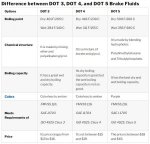Our wrench twisting Mattech found some compromised rubber in a NOS rebuilt M135 brake system with DOT 5. It all comes down to the question......
What type of Rubber is not compatible with DOT 5 brake fluid?
Here's some previous valuable info
https://www.steelsoldiers.com/threads/dot-5-seals.51445/
"""""""DOT 5 is a silicone fluid. The types of rubber NOT recommended for use with silicone fluids are
silicone rubber and fluorosilicone rubber""""""
Now if we have some of that silicone or fluorosilicone rubbers in your wallet /brake system then swapping to DOT 5 would be bad.
https://www.canadarubbergroup.com/en-ca/blog/fluorosilicone-rubber
Since this fluoro mess us up silicone rubber was developed by DOW in the 50's.....it lends some logic that it's out there.
Fluorosilicone rubber (FVMQ) offers good weathering resistance, ozone resistance and thermal stability

www.rado-rubber.com
""""""" It is used to manufacture parts such as O-rings, seals, hose liners (e.g. in turbocharger hoses) and automotive diaphragms, primarily for fuel systems at temperatures of up to 250°C. Other applications include natural gas installations, natural gas production equipment and aerospace engineering. Since fluorosilicone compounds have a high shrinkage rate, products made from this material are often produced in different ways from those made from other elastomers. """"""""""

www.sciencedirect.com
One then must ask if DOT 3 is hard on rubber and that hunt is a little less straight forward.

www.saabcentral.com
""""""DOT3 is an aliphatic polyether.
DOT4 is borate ester based. Both of these fluids are designed for use in braking systems fitted with rubber cups and seals made from styrene-butadiene rubber (SBR), or a terpolymer of ethylene, propylene, and a diene (EPDM).""""""""
Standard brake fluid compatible material is EPDM rubber (just like a radiator or heater hose). This is also a water-compatible materialbut doesn't like petroleum oils. Most petroleum-contacted o-rings are Buna-N or nitrile rubber.

everythingwhat.com
"""""""""Standard brake fluid compatible material is
EPDM rubber (just like a radiator or heater hose). This is also a water-compatible materialbut doesn't like petroleum oils. Most petroleum-contacted
o-rings are
Buna-N or
nitrile rubber.
Click to see full answer.
"""""""""Similarly, it is asked, is brake fluid good for rubber?
All polyethylene glycol-based
fluids will not harm healthy
rubber parts. If the
brake fluid becomes unable to control the pH or other corrosive elements, the
rubber and metal parts will deteriorate over time. If you have an older vehicle and are worried about boiling the
fluid, use DOT 4 or 5.1
brake fluid.
Also Know, is nitrile resistant to brake fluid?
Nitrile or Buna-N O-rings produce general purpose seals that are tear-
resistant and can withstand abrasive treatment.
Nitrile O-rings are not advisable for use with automotive
brake fluid, ketones, phosphate ester hydraulic
fluids, and nitro and halogenated hydrocarbons.
Likewise, people ask, what hose is compatible with brake fluid?
Their cloth braided fuel
hose is compatible with brake fluids. I use two sizes, 5mm and 7mm, and both are fine.
Are all DOT 3 brake fluids compatible?
All DOT 3, 4 and 5.1
brake fluids are
compatible with each other and with
all systems.
All polyethylene glycol-based
fluids will not harm healthy rubber parts. Also, the additive packages will not damage or distort any rubber parts."""""""""""
What we know is DOT 5 has chewed up or rather, melted rubber, in some of the older brake rubbers. We know DOT 5 has settled water in low lines or wheel cylinders. We had one DOT 5 line freeze and split open.....but we're up in Canada so eventually everything freezes and splits open.








